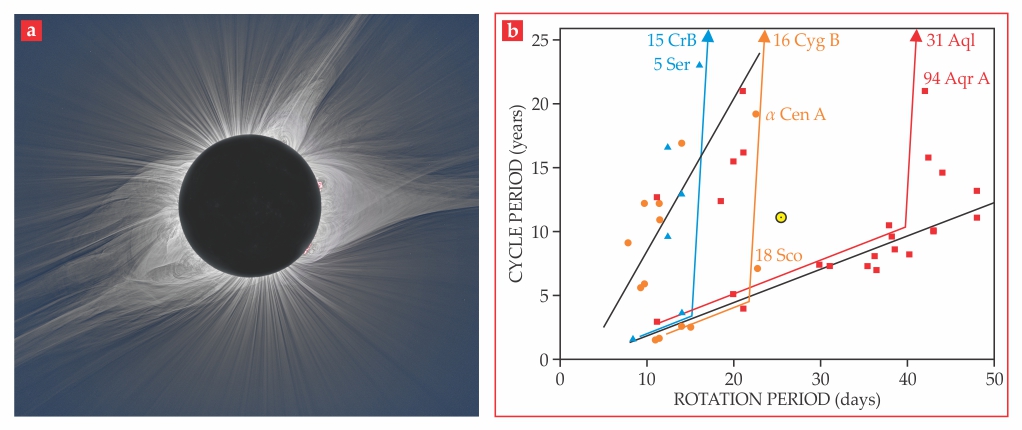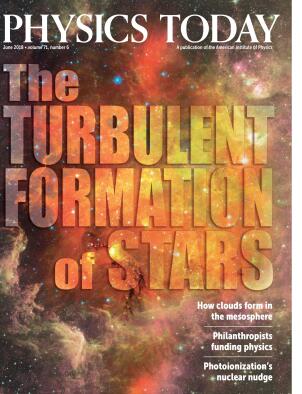The Sun’s magnetic midlife crisis
DOI: 10.1063/PT.3.3956
The Sun is just one of a hundred billion stars in the Milky Way galaxy. Our front-row seat on Earth allows us to observe it in much greater detail than we can for other stars. However, those observations provide only one snapshot in the life story of stars like the Sun. To piece together the entire tale, astronomers need to study other stars that are younger and older. Their observations have revealed something unexpected that never could have come to light from studies of our Sun in isolation.
Magnetic braking
Almost half a century ago, astrophysicist Andrew Skumanich noticed that rotation and magnetism in stars are intricately linked. Based on observations of the Sun and a few young star clusters for which stellar ages could be estimated, he proposed that both the rotation rate and the magnetic field strength in stars are inversely proportional to the square root of age.
During a total solar eclipse (panel a of the

The dynamic Sun. A solar eclipse (a) makes visible the solar wind, material that follows magnetic field lines as it leaves the Sun’s surface. (Photo courtesy of Miroslav Druckmüller.) (b) In this plot relating the length of the stellar magnetic cycle to the rotation period, the solid black lines show the two distinct relationships observed by Erika Böhm-Vitense about a decade ago. Points are colored according to the star’s surface temperature; hotter F-type stars are blue, G-type stars like the Sun are orange, and cooler K-type stars are red. The colored lines show representative evolution paths that deviate from Böhm-Vitense’s lower relationship when the rotation period corresponds to the critical Rossby number heralding the shutdown of magnetic braking. (For a possible interpretation of the upper relationship, see T. Metcalfe, J. van Saders, https://arxiv.org/abs/1705.09668

By the late 1980s, astronomers had recognized that magnetic braking is stronger in more rapidly rotating stars. Thus, even though stars are formed with a range of initial rotation rates, the rates tend to converge to a single, mass-dependent value. For stars that, like the Sun, have outer convection zones where temperature gradients drive the rise and fall of fluid elements, the convergence time is roughly 500 million years. However, the evidence for the above scenario relies on studies of rotation in members of young star clusters; until recently the only older star available for testing the ideas was the Sun.
Old but spry
The Kepler Space Telescope changed our understanding of how rotation and magnetism evolve in Sun-like stars. After its launch in 2009, Kepler spent four years monitoring thousands of stars and a few clusters. Rotation of the stars in clusters with ages up to 2.5 billion years agreed with previous expectations. But a different behavior was revealed by some of the isolated stars, whose ages were determined from asteroseismology, essentially analyses of brightness oscillations. The younger stars agreed with the clusters, but the older stars rotated more quickly than expected. Beyond middle age, the angular momentum of stars no longer appeared to be decreasing over time.
The anomalous rotation became significant near 4–5 billion years for so-called G-type stars, the class that includes our Sun, but it appeared after 2–3 billion years for hotter F-type stars and after 6–7 billion years for cooler K-type stars. That dependence on the temperature suggested a link to the convection zones, whose fluid motion is thought to contribute to the generation of magnetic fields. Specifically, magnetic braking appears to shut down at a constant Rossby number, defined as the ratio of the rotation period to the turnover time for fluid elements in the convection zone. Cooler stars have deeper convection zones with longer turnover times, so they would continue braking for longer before reaching the slower rotation required to yield the critical Rossby number. In a 2016 Nature paper, Jennifer van Saders and colleagues reproduced the observations with rotational evolution models based on that idea.
Ground-based spectroscopic observations of the Kepler stars revealed that the critical Rossby number could also be interpreted in terms of magnetic fields. It turns out that two specific spectral lines from calcium ions can serve as a useful proxy for the strength and fractional area covered by magnetic fields. The critical Rossby number corresponds to a specific luminosity of calcium emission from the chromosphere, the part of the solar atmosphere just above the light-emitting photosphere. Stars with different surface temperatures take different amounts of time to reach that level of chromospheric emission. Note, though, that as the star ages, chromospheric emission continues to decrease before eventually settling down to a constant value; in that regard it differs from stellar rotation, which is locked in place by the shutdown of magnetic braking at the critical Rossby value.
As the star’s rotation rate decreases and the Rossby number approaches the critical value, the global magnetic field is concentrated into smaller spatial scales and is a much less efficient means for shedding angular momentum. How might that concentration come about? As the rotation period becomes comparable to the convective turnover time, the imprint of Coriolis forces on the convective patterns is diminished. The reduced effect might naturally lead to a change in the character of differential rotation that modifies the dominant scale of the global magnetic field.
Demise of the solar cycle
The revised picture of rotational and magnetic evolution just described not only explains the new observations from Kepler, it also addresses a long-standing puzzle about the 11-year sunspot cycle. The plot in panel b of the
The updated version of the diagram colors the points to indicate the surface temperature of each star. At the critical Rossby number corresponding to the shutdown of magnetic braking, stars deviate from one of the relationships observed by Böhm-Vitense; eventually the stars will evolve to have constant chromospheric emission. Stars that previously seemed to be outliers, including the Sun, 5 Serpentis (5 Ser), Alpha Centauri A (α Cen A), and 94 Aquarii A (94 Aqr A), can now be understood as transitioning from predominantly large-scale to smaller-scale global magnetic fields and longer magnetic cycles. The other stars indicated on the diagram are 18 Scorpii (18 Sco), 15 Coronae Borealis (15 CrB), 16 Cygni B (16 Cyg B), and 31 Aquilae (31 Aql).
Future tests of those new ideas about magnetic evolution will come from ground-based chromospheric emission measurements of Kepler targets that span the putative magnetic transition and from asteroseismology with the newly launched Transiting Exoplanet Survey Satellite to determine precise masses and ages for the bright stars with known magnetic cycles. Additional insights might also come from more difficult measurements of differential rotation and from reconstructions of the magnetic field geometry obtained from analysis of the polarization of stellar light.
References
► A. Skumanich, “Time scales for Ca II emission decay, rotational braking, and lithium depletion,” Astrophys. J. 171, 565 (1972). https://doi.org/10.1086/151310
► J. L. van Saders et al., “Weakened magnetic braking as the origin of anomalously rapid rotation in old field stars,” Nature 529, 181 (2016). https://doi.org/10.1038/nature16168
► E. Böhm-Vitense, “Chromospheric activity in G and K main-sequence stars, and what it tells us about stellar dynamos,” Astrophys. J. 657, 486 (2007). https://doi.org/10.1086/510482
More about the Authors
Travis Metcalfe is a senior research scientist at the Space Science Institute in Boulder, Colorado.

